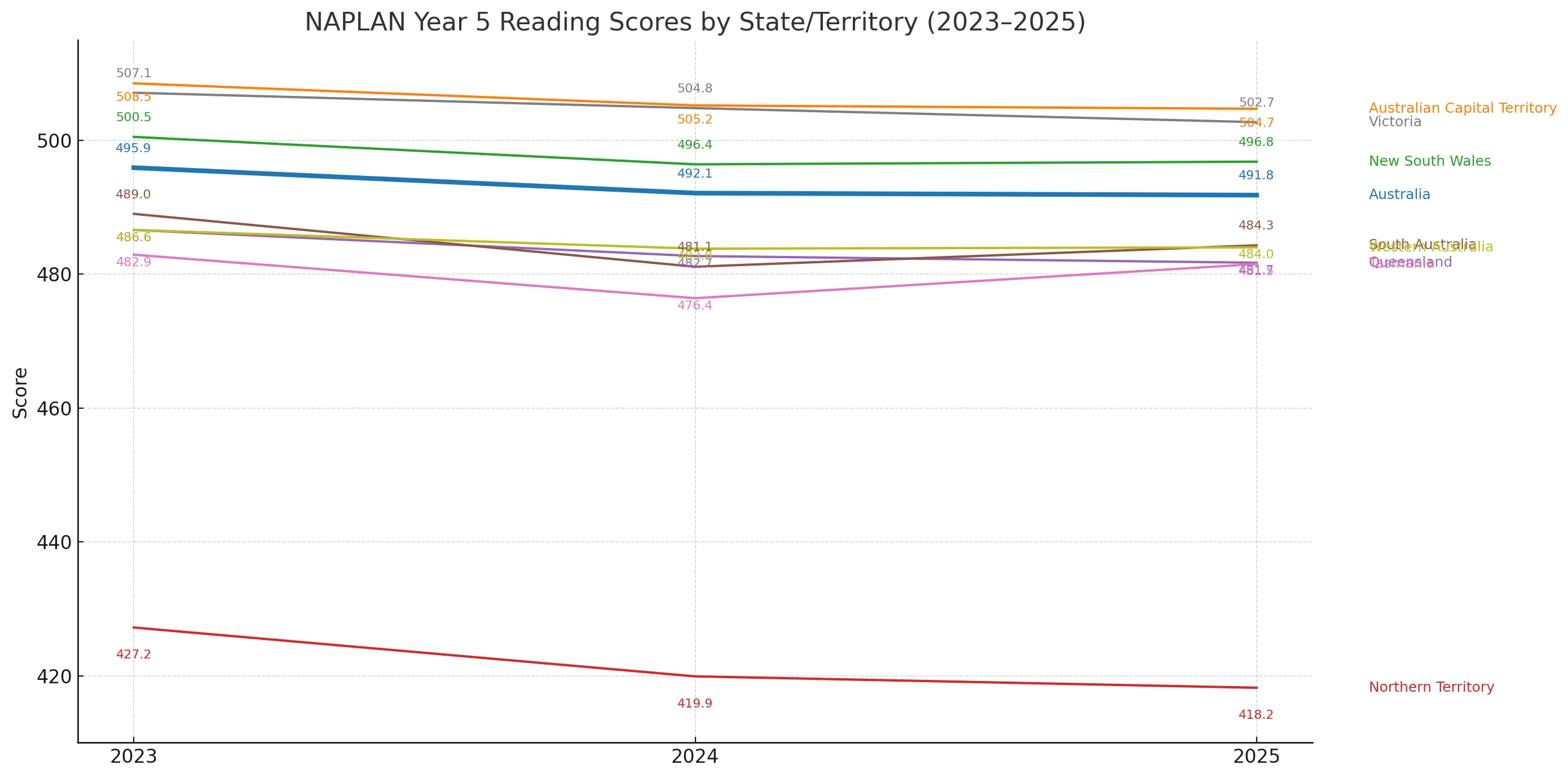
What is the NAPLAN?
The National Assessment Program – Literacy and Numeracy (NAPLAN) is a nationwide assessment conducted annually in Australia for students in Years 3, 5, 7, and 9. It tests foundational skills in reading, writing, language conventions (spelling, grammar and punctuation), and numeracy.
NAPLAN is not a test of content knowledge, but rather a measure of how well students can apply skills in literacy and numeracy that are developed over time through the school curriculum. The results are used by governments, schools, and educators to evaluate educational programs and track student progress at a national level.
Why is it done at Year 5?
Year 5 is a critical checkpoint in a student's academic journey. By this stage, students have had several years of structured learning and are transitioning from the foundational years of primary education toward more complex thinking and problem-solving. NAPLAN at Year 5 helps assess how well students have consolidated literacy and numeracy skills developed in earlier years and whether they are ready to take on the increasing demands of upper primary and early secondary education.
It also provides a valuable point of comparison with Year 3 results, enabling educators and policymakers to track student growth over time. This growth data is crucial for identifying learning gaps early, adjusting teaching strategies, and ensuring that all students are on track to meet national standards. For parents, Year 5 NAPLAN results offer a mid-point snapshot of their child's development and progress in core academic skills.
What are the proficiency levels?
As of 2023, NAPLAN results are reported using proficiency levels rather than numerical bands. These levels are designed to provide clearer insights into a student’s development and where they sit in relation to national expectations.
There are four proficiency levels:
- Exceeding – The student demonstrates skills well above the expected level for their year.
- Strong – The student demonstrates solid understanding and skills at or above expectations.
- Developing – The student shows partial achievement but is not yet consistently meeting expectations.
- Needs Additional Support – The student requires targeted teaching and support to meet expected skills.
These categories help teachers and parents better understand whether a student is on track, ahead, or in need of support.
Although there are no official benchmarks, most schools are aiming to have at least 66% of their students as “Strong” or “Exceeding”.
What domains are being assessed?
There are five domains that are assessed:
- Reading: Assesses a student's ability to comprehend, interpret, and analyse a range of written texts, including narratives, information texts, and persuasive writing. Students are required to read passages and answer multiple-choice or short-answer questions based on the content.
- Writing: Evaluates how well students can express ideas through written language. Students are given a prompt (either persuasive or narrative) and assessed on their ability to structure their ideas, use appropriate vocabulary, organise paragraphs, and apply correct grammar and punctuation.
- Spelling: Measures students’ understanding of common spelling patterns and their ability to apply them correctly in written words. This helps identify their grasp of phonics, word structure, and spelling rules.
- Grammar and Punctuation: Assesses students’ knowledge and correct use of sentence structure, verb agreement, capitalisation, commas, apostrophes, and other grammatical conventions necessary for clear written communication.
- Numeracy: Tests students’ ability to solve problems using mathematical knowledge across number, algebra, measurement, geometry, and statistics. It includes both multiple-choice and short-answer questions, requiring reasoning and calculation.
What were the results in 2025?
Reading

Victoria and the ACT consistently outperform the national average, with Victoria maintaining one of the highest scores at 502.7 in 2025. The national average has remained relatively stable, with only a slight decline from 495.9 in 2023 to 491.8 in 2025. In contrast, the Northern Territory continues to trail significantly, falling to just 418.2 in 2025—a gap of more than 70 points from the national leaders. While most states show marginal declines or recovery in 2025, the overall trend reflects stagnation rather than progress, particularly in the middle-performing states like Queensland and Western Australia.
.webp)
Australia performs strongly in Year 5 Reading, with over 72% of students nationally reaching the Strong or Exceeding levels. The ACT and Victoria lead the way, with more than 78% of students in the top bands and very few needing additional support. New South Wales also performs well, with strong results across both achievement and excellence.
By contrast, the Northern Territory once again stands out for concerning results—over a third (33.7%) of students need additional support and just 7.4% are in the Exceeding category. This large disparity underlines the equity challenge in Australian education, particularly for remote or disadvantaged regions. Overall, the majority of jurisdictions show solid literacy development by Year 5, but the proportion of students at the top end still varies significantly.
Writing
.webp)
Victoria remains the standout performer, consistently scoring the highest, with 494.0 in 2025, despite a slight dip compared to previous years. New South Wales also maintains strong results, though its scores have fallen from 493.2 in 2024 to 486.7 in 2025. Nationally, there is a downward trend, with Australia's average falling from 484.8 in 2024 to 479.6 in 2025, suggesting that writing performance is weakening across most states.
The Northern Territory continues to face significant challenges, dropping to 395.5 in 2025, which is more than 80 points below the national leaders. Meanwhile, other states like Queensland, Tasmania, and Western Australia show relatively flat trends, with small declines from 2024 to 2025.
.webp)
Nationally, over 65% of students are achieving in the Strong or Exceeding categories, with Victoria leading the country in writing proficiency: 60.6% Strong and 12.2% Exceeding. New South Wales and Western Australia also demonstrate strong performance, with more than half of students meeting or exceeding expectations.
The most concerning result is once again the Northern Territory, where over a third (36.7%) of students need additional support and just 4% are exceeding expectations. Queensland, South Australia, and Tasmania show more modest results, with higher numbers in the Developing band. The data points to clear state-level disparities in writing outcomes, particularly at the top and bottom ends of performance.
Spelling
.webp)
Spelling scores across Australia have remained relatively stable, with a national average of 487.4 in 2025—very close to 2023 levels. Once again, New South Wales and Victoria lead the country in performance, with scores consistently near or above 495. The ACT also maintains strong results, close behind the national leaders.
In contrast, the Northern Territory has seen a sharp and consistent decline, falling to just 401.8 in 2025. This puts it over 90 points behind the highest-performing states. Tasmania, while showing some recovery in 2025, continues to trail the national average. Most other states, including Queensland and Western Australia, have experienced marginal fluctuations but remain stable overall. The data highlights persistent equity gaps in spelling outcomes, especially for lower-performing jurisdictions.
.webp)
Spelling results reveal a mixed national picture, with most states showing a large concentration of students in the Developing and Strong bands. Victoria stands out as the top-performing state, with 110% of students reported as achieving in the Strong band and 33.7% in Exceeding—suggesting potential reporting overlap or data scaling issues. New South Wales also performs well, with over a third of students in the Exceeding band.
In contrast, the Northern Territory presents serious concerns: more than 70% of students require additional support, and fewer than 15% reach the Exceeding category. Queensland and Tasmania also have elevated levels of students in the Developing band, indicating that while students may be on track, fewer are reaching top-level proficiency.
The chart underscores both achievement and equity challenges in spelling proficiency by Year 5.
Grammar and punctuation
.webp)
Victoria and New South Wales continue to lead the nation in grammar and punctuation performance, with Victoria reaching a peak of 507.1 in 2025 and NSW close behind at 506.7. The ACT also shows strong results, consistently above the national average and maintaining stable growth over time.
At the national level, scores have remained relatively steady, with only a minor decline from 498.4 in 2024 to 497.2 in 2025. In contrast, the Northern Territory has seen a substantial and continuous decline across all three years, dropping to just 402.6 in 2025, which highlights persistent challenges in student outcomes.
While most other states, including Queensland and South Australia, saw minor declines in 2025, their overall performance remains close to the national benchmark. The results underline a consistent east coast advantage in literacy-related domains and the need for targeted support in lower-performing jurisdictions.
.webp)
The majority of students nationally are achieving at or above the expected level, with 63.1% in the Strong or Exceeding categories. Victoria and the ACT stand out as top performers, with nearly 67% of students in the top two bands. New South Wales also performs well, especially in the Exceeding category, where nearly 1 in 5 students are excelling.
At the other end of the scale, the Northern Territory continues to face serious challenges. Over 40% of students require additional support, and only 5.7% are achieving at the Exceeding level. States like Queensland, Tasmania, and South Australia show moderate performance but with noticeably fewer students in the highest band compared to the national leaders.
The results highlight a consistent divide in literacy achievement across regions, emphasising the need for both targeted support in lower-performing jurisdictions and strategies to lift more students into the Exceeding band nationwide.
Numeracy
.webp)
Numeracy scores nationally have shown a modest upward trend, with the Australian average rising from 487.6 in 2023 to 491.8 in 2025. Victoria continues to lead, reaching the highest score in 2025 at 502.7, followed closely by New South Wales and the ACT (both at 499.1). These states consistently outperform the national average and show steady growth year-on-year.
On the other end of the spectrum, the Northern Territory remains well below the national average, with a score of just 417.5 in 2025—more than 80 points behind the top-performing state. While other states such as South Australia, Tasmania, and Western Australia have shown gradual improvement, their progress remains incremental.
Overall, the data shows national improvement in numeracy outcomes, with strong performances from eastern states, but ongoing concerns for equity and growth in lower-performing jurisdictions.
.webp)
The national numeracy profile shows promising results, with nearly 70% of students in the Strong or Exceeding bands. Victoria and the ACT are the top performers, with Victoria having 57.6% of students in the Strong band and 15.9% in Exceeding. New South Wales also performs strongly, with the highest percentage of students (16.5%) in the Exceeding category.
In contrast, the Northern Territory continues to lag behind, with 34.7% of students needing additional support and only 3.4% in the Exceeding band. Other states such as Tasmania, Queensland, and South Australia show solid performance but still have a sizeable proportion of students in the Developing or Needs Support categories.
Overall, numeracy achievement in Year 5 appears relatively stable and strong for most states, though the persistent gap between higher- and lower-performing jurisdictions suggests a continued need for targeted interventions.
Final thoughts
Year 5 students are performing well across most literacy and numeracy domains, with Reading and Numeracy emerging as consistent strengths. However, Writing stands out as a clear national concern—highlighting the importance of investing in writing instruction, feedback, and practice across all Australian classrooms to close this growing gap.







